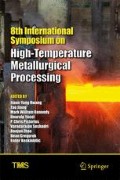Abstract
During the tapping and casting of manganese ferroalloys, fumes are generated and released to the working environment. The fumes are mostly composed of metallic oxides generated due to reaction between high temperature molten metal and ambient oxygen in the air. From an environment perspective, it is important to limit these emissions. However, to do so, it is important to understand fuming mechanisms and kinetics as well as fume compositions, i.e. element behavior during the oxidation process of liquid manganese ferroalloys. Silicomanganese alloys are composed of a minimum of 65 wt% Mn and 17 wt% Si, 2 wt% C as well as minor and trace elements . These elements include Fe, Mg, Al and other elements originating from ores and reductants. Trace elements behavior in fume from liquid silicomanganese generated under an impinging air jet in the temperature range of 1450–1700 °C has been investigated in this work. The thermodynamic and kinetic conditions governing the generation mechanisms are discussed.
References
Å. Hobbesland, H. Kjuus, D.S. Thelle, Mortality from nonmalignant respiratory diseases among male workers in Norwegian ferroalloy plants. Scand. J. Work Environ. Health 23, 342–350 (1997)
A.D. Kappos et al., Health effects of particles in ambient air. Int. J. Hyg. Environ. Health 207, 399–407 (2004)
H. Kjuus, A. Andersen, S. Langård, K.E. Knudsen, Cancer incidence among workers in the Norwegian ferroalloy industry. Br. J. Ind. Med. 43, 227–236 (1986)
S. Rencken, in Analysis of secondary fume generation and capture during the tapping of high carbon ferromanganese. Report, University of Petoria, (2013)
European Environment Agency, EMEP and EEA emission inventory guidebook. Report (2013)
M.K. Næss et al., Element distribution in silicon refining: thermodynamic model and industrial measurements. JOM 66(11), 2343–2354 (2013)
M.K. Næss, I. Kero, G. Tranell, A new method for estimation of emissions and sources of measurements error in the silicon refining process. JOM 65(8), 997–1006 (2013)
I. Kero, M.K. Naess, G. Tranell, Particle size distributions of particulate emissions from the ferroalloy industry evaluated by electrical low pressure impactor (ELPI). J. Occup. Environ. Hygiene 12(1), 37–44 (2015)
I. Kero et al. Fume formation from liquid ferromanganese. Paper presented at the 2015 sustainable industrial processing summit, Antalya, Turkey, 4–9 October 2015, pp. 135–146
P. Cowx et al. The use of fine water sprays to suppress fume emissions when casting refined ferromanganese. Paper presentated at the Infacon XIV. Kyiv, Ukraine, 1–4 June 2015, pp. 81–90
C. Gray, in Fume Formation in Electric Arc Welding. Ph.D. thesis, University of Bradford (1980)
M. Gonser, H. Theodore, Arc Welding Health Effects, Fume Formation Mechanisms, and Characterization Methods (INTECH Open Access Publisher, USA, 2011), p. 305
E.H. Myrhaug, H. Tveit, Material balances of trace elements in the ferrosilicon and silicon processes. Paper presented at the 58th electric furnace conference and 17th process technology conference proceedings, iron and steel society, Orlando, US, Nov. 12–15, pp. 591–604 (2000)
E.T. Turkdogan, P. Grieveson, L.S. Darken, Enhancement of diffusion-limited rates of vaporization of metals. J. Phys. Chem. 67(8), 1647–1654 (1963)
M.K. Næss et al., Parameters affecting the rate and product of liquid silicon oxidation. Oxid. Met. 82(5), 395–413 (2014)
M. Ratto et al., Oxidation of metals with highly reactive vapors: extension of Wagner theory. Metall. Mater. Trans. B 32(5), 903–911 (2001)
Outotec, HSC. 7.1, (2016)
I. Kero, G. Tranell, Active oxidation and fume formation from liquid SiMn. Paper presented at TMS Annual Meeting. Nashville, USA, pp. 77–84 (2016)
T.B. Massalski, Binary Alloy Phase Diagrams (Materials Park, ASM International, Ohio, 1990)
Acknowledgements
These studies were funded by Norwegian Research Council (NFR) through the project “DeMaskUs”, grant number 245216.
Author information
Authors and Affiliations
Corresponding author
Editor information
Editors and Affiliations
Rights and permissions
Copyright information
© 2017 The Minerals, Metals & Materials Society
About this paper
Cite this paper
Ma, Y., Kero, I., Gates, S.J.F., Tranell, G. (2017). Trace Elements Behavior During the Oxidation of Liquid SiMn Alloy. In: Hwang, JY., et al. 8th International Symposium on High-Temperature Metallurgical Processing. The Minerals, Metals & Materials Series. Springer, Cham. https://doi.org/10.1007/978-3-319-51340-9_22
Download citation
DOI: https://doi.org/10.1007/978-3-319-51340-9_22
Published:
Publisher Name: Springer, Cham
Print ISBN: 978-3-319-51339-3
Online ISBN: 978-3-319-51340-9
eBook Packages: Chemistry and Materials ScienceChemistry and Material Science (R0)

